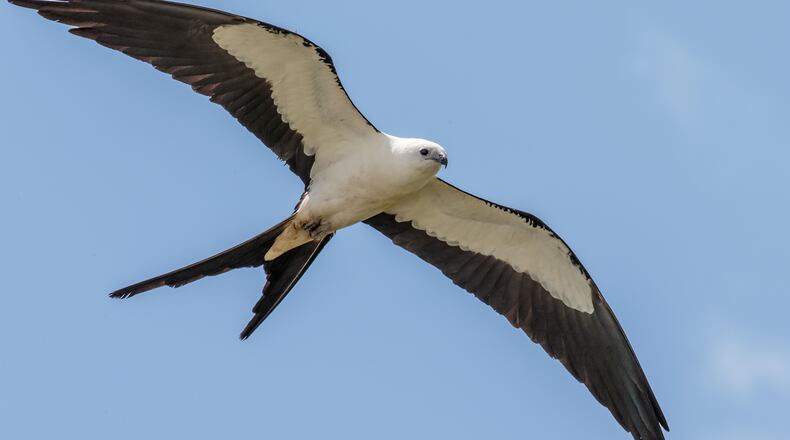For the past few weeks, the prospect of seeing two of Georgia’s — and the nation’s — most spectacularly flying bird species has been drawing birders, including me, to some old agricultural fields near Watkinsville in Oconee County.
The birds are swallow-tailed kites and Mississippi kites, stunning, streamlined, crow-size birds of prey. After nesting this spring in cypress swamps and riparian areas of Georgia’s Coastal Plain, many of them have moved inland to the Piedmont to gather in small mixed flocks and fatten up in preparation for fall migration to Central and South America.
In the process, they have been putting on breathtaking shows as they skillfully glide, swoop and roll to snatch airborne insects or pick off small creatures on leaves and twigs — as they were doing last week over some old hayfields and pastures in Oconee County.
With its long, deeply forked tail, huge wingspan and small body, the black-and-white swallow-tailed kite resembles a large swallow at a distance. It’s “surpassed by few birds in skill and gracefulness,” said the late Georgia ornithologist Thomas Burleigh. “While normally seen low overhead, it ascends at times to great heights, where it performs aerial evolutions that demonstrate its mastery of the air.”
The grayish Mississippi kite may not be as striking, Burleigh said, “but it is nevertheless swift and graceful in the air, displaying an ability that cannot fail to impress the observer.”
By mid-September, the kites will be gone, headed back to their winter grounds in the southern tropics.
More birding news: The Atlanta Audubon Society this week became a statewide group, the Georgia Audubon Society. “We will seek to adopt a broader focus to connect birds and people across the state,” said Executive Director Jared Teutsch.
IN THE SKY: From David Dundee, Tellus Science Museum astronomer: The annual Perseid meteor shower will peak at about 50 meteors per hour next week. Best viewing: Tuesday through Thursday late night, in the northeast sky.
The moon will be last quarter on Tuesday. Mercury is low in the east an hour before sunrise. Venus is higher in the east about three hours before sunrise. Mars rises in the east an hour before midnight and appears near the moon Saturday night. Jupiter and Saturn rise in the east around sunset.
About the Author
Keep Reading
The Latest
Featured


